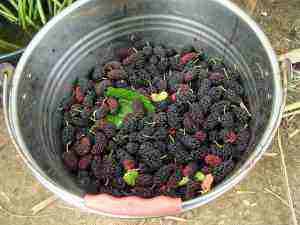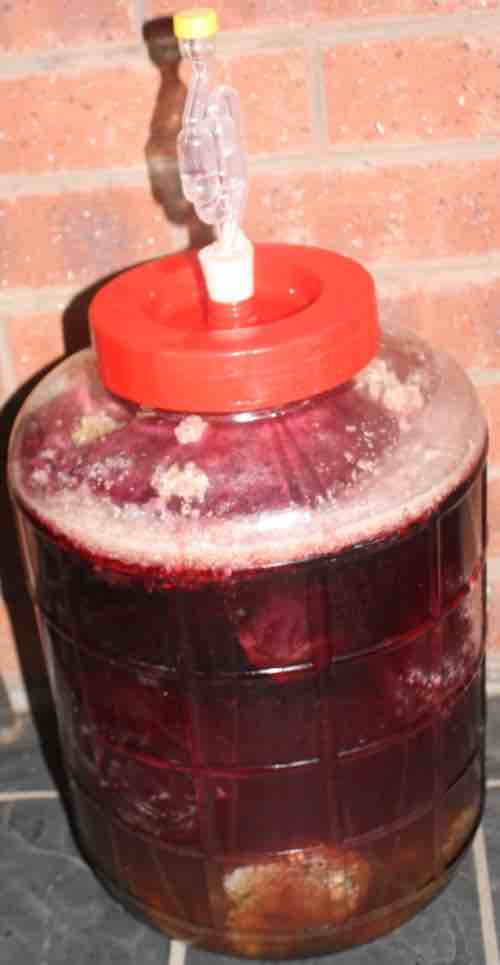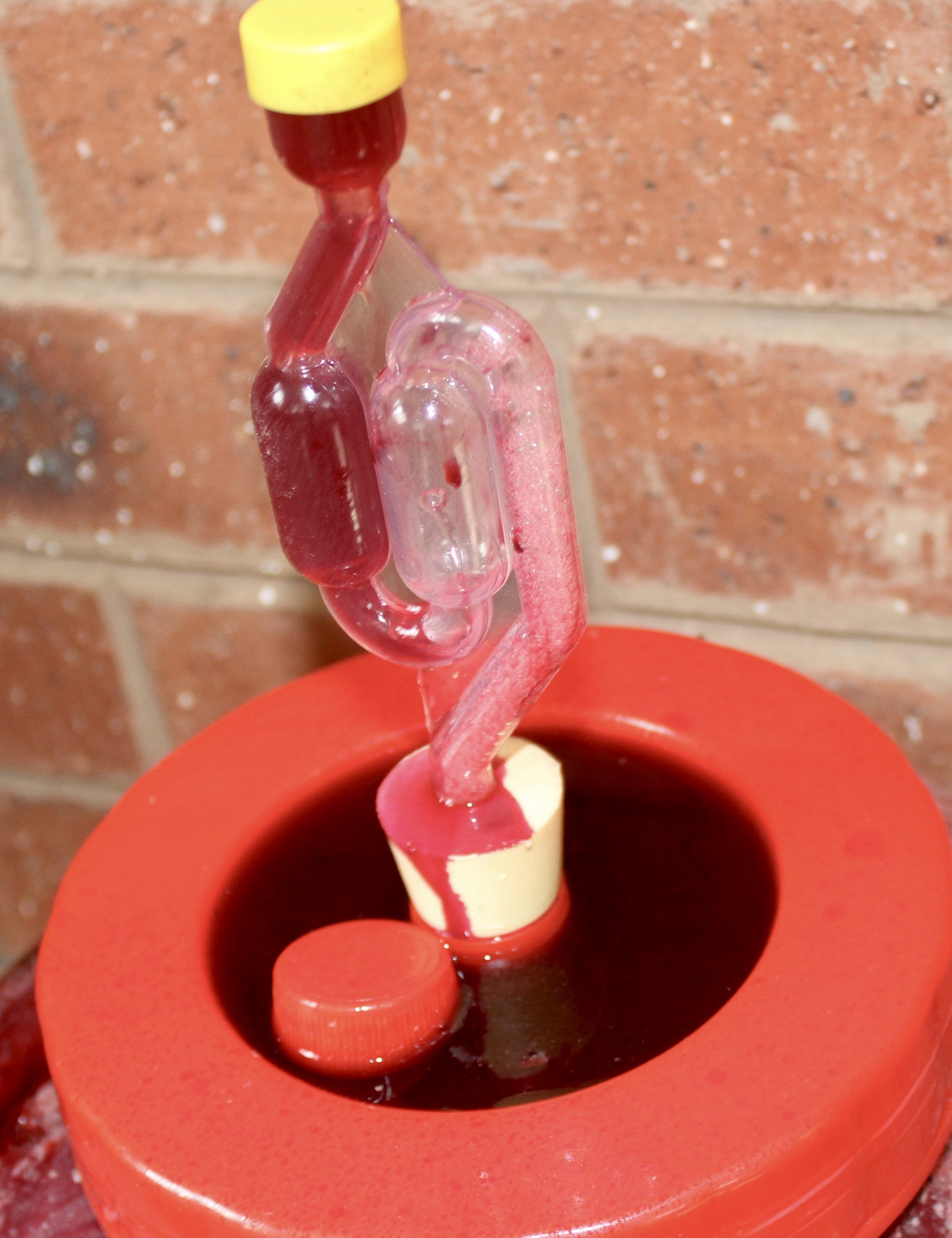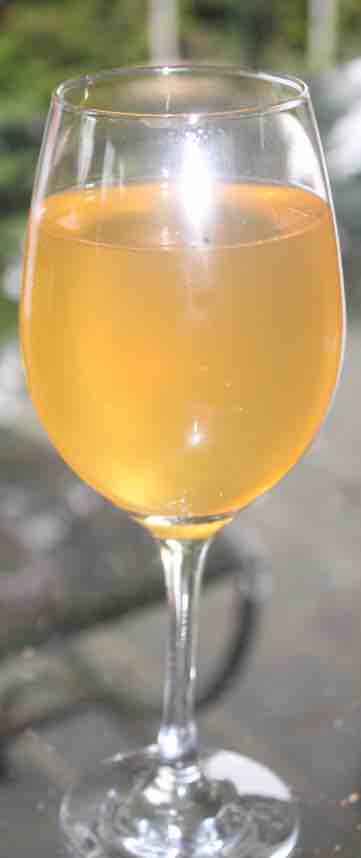- Bernard Preston homepage
- Purples
- Mulberry Honey Mead
Mulberry honey mead
A mulberry honey mead is really known as a melomel; it's a wine with a difference.
We have a glut of mulberries this year and are looking for ways to preserve the important phytonutrients in the fruit.
Mead-making is really for beekeepers who also have access to large amounts of fruit. If you are going to brew a 23 litre carboy you will need nearly 20 pounds of natural honey; in South Africa that will cost you around R1500 or more.
We get most of the honey from the gleanings after decapping; the wax is removed from the surface of the comb to allow extraction.

Sweetness
The sweetness of your mulberry mead will be determined by the amount of honey added and to a lesser extent by the sugars in the fruit; most are fermented to alcohol and carbon-dioxide.
Ingredients
- 10 kg mulberries
- 8kg honey
- Or 21 kg of wet comb and cappings mix[2]
- 1 large lemon
- 10 cloves
- 1 large ginger-root the size of your hand, peeled and cut into 3mm thick slices.
- 1tsp
black tea, 2 mulberry leaves and the zest of one lemon. Boil for 5
minutes in rain water and allow to brew for a quarter of an hour. Strain
before adding to the carboy.
- 1 tsp wine yeast added to 1 cup of warm, unchlorinated water for 20 minutes to hydrate.
- 1 piece of comb the size of a large coin with fresh pollen for a yeast nutrient.
- Rain or spring water.
Also needed are two large muslin bags that are frequently used in making a fruit-jelly and about 50 glass marbles to weight them down. I am now using smooth pebbles from a mountain stream. Carbon dioxide inside the bag lifts it to the surface and out of the liquid.
This is still not a settled issue. In time I will report on the weight of the pebbles and marbles; on this occasion it was not sufficient allowing the bags to float partially out of the liquid.
Wax in the cappings
The preferred method more recently is to place the cappings in a large bucket, add 10 litres of warm, unchlorinated water and then use a potato masher. Strain the dissolved honey into the carboy.
The wax itself plays no part in the fermentation and takes up too much space to my mind; we now strain it off from the honey in the cappings.
We routinely like to add a few small chunks of honeycomb or even old wax from the brood chamber[3]; the all-hive method. No other yeast nutrients are then needed. The cells must be pricked to give access for fermentation.
Go for it

I made this batch of mulberry honey mead, or melomel to be more precise on 8th October, 2022.
- Sanitise and rinse all the equipment.
- Place wet comb and gleanings into a bucket and using 10 litres of unchlorinated water agitate with a potato masher until all is well broken up. Strain into the carboy, removing most of the wax-cappings.
- Place the lid on the carboy and vigorously agitate the liquid for 10 minutes to oxygenate the mead[8]; it's heavy so we recommend two people do this.
- Peel the lemon, removing all the bitter pith. Cut into slices, extracting the pips. Use all the pulp and juice.
- Add the cloves and chopped-up ginger to the large muslin bags.
- Place the mulberries and lemon into the muslin bags weighted down with 30 marbles each so they will sink below the level of the liquid.
- Boil 1tsp black tea, 2 mulberry leaves and zest of one lemon for 5 minutes in rain water; allow to brew for a quarter of an hour. Strain before adding to the carboy.
- Ensure there is at least a 10cm space between the top of the liquid and the lid; it will start foaming once fermentation starts. Watch carefully that it does not overflow in warm weather.
- Measure the acidity and SG; and taste.
- Add 1 tsp white-wine yeast for every 5 litres (see update below) of must is the recommendation[4]; stir into warm water at 35C to hydrate and pour it in after 20 minutes. Make sure there is some fresh pollen for a nutrient.
- Fit the seal and air-trap.
- Ferment for 6 days then agitate vigorously if there is any sign of fermentation slowing.
As a general rule fruit with seeds should be removed after two weeks to prevent spoilage from the oils. Mulberries are fine; you can leave them in the mead provided they are submerged for a long period.
If you use any honeycomb in the fermenter every cell must be pricked open first.

This is what happens if the carboy is over-filled. Making sure the bags of fruit are submerged is part of the secret and not using much comb; extract all the honey from the cappings and discard the latter for melting down.
Vigorous stirring of the liquid periodically with a long-handled plastic spoon will help with degassing. I now use only 1tsp of yeast in the 23L carboy.
There is merit in using a plastic bucket with a wide throat to prevent this provided you siphon off the liquid into glass at the 6 weeks stage.
Update
This is perhaps the best mead I have ever made so I have left the recipe exactly as it was done; but here are some updates.
- Mulberries produce a vigorous fermentation, far greater than any other I have experienced. I now add only 1/2 tsp of Vin 13 yeast in a 23L carboy.
- I leave a substantial ullage above the liquid in the carboy initially; even 10cm. It is soon filled with a head of CO2 so no anxiety of oxidation.
- Then when fermentation slows, reduce the ullage to 2cm by adding the remaining boiled spring or rainwater.
- The berries have a low specific gravity and the CO2 seems to build up in the bag making it float above the liquid and threatening to block the bubbler; add extra river stones.
- 10kg is a lot of fruit, taking up too much space; you will get less than 15 litres litres of mead from a 23L carboy. I now mash the lot, with only a third going into the bag in the carboy.
- Instead of adding the water directly to the carboy, I now use it to extract as much of the juice from the remaining pulped mulberries; squish them vigorously with the potato masher.
6 weeks stage
- After 6 weeks test the pH again.
- If a plastic fermenter is being used rack now into glass demijohns, still under airlock.
- Fill the gap above the liquid with a syrup made from a ratio of 1 litre of water to 130g fructose is the official recommendation; I'll use a little mature mead instead.
- Leave for 12 weeks. This secondary fermentation is when the mead will mature.
On 19.11.2022 I wracked the mulberry honey mead into three 5L demijohns with air-locks; fermentation has ceased but may start again. The pH was 3 and the SG 0,095.
1.25ml of bicarb was slowly added to each demijohn to raise the pH by 0,5.
The taste was indifferent but not unpleasant.
12 weeks stage
- After 12 weeks or when fermentation has stopped, do SG and pH tests again.
- If the specific gravity is too high, simply add boiled water.
- Then siphon the liquid from the fermenter into demijohns trying to avoid the sediment.
- If it is clear and tastes good, bottle; it will likely need to be racked again.
On the 16th December, 2022 I did the second rack; fermentation had stopped completely. pH was 3.0 so I carefully added 1tsp of bicarb to each demijohn, making sure that excessive foaming did not cause a disaster as has happened in the past. The flavour is good and it's not too sweet.
I used a bottle of mature all-hive mead to top up the third demijohn; it will of necessity be a blend.
Acidity
The pH range you want is 3,5 to 4,5. Add 1.25ml of bicarb or tartaric acid per 0,5 adjustment on 5 litres in small tranches; it may bubble over. You could use lemon juice if it is too high.
After mixing the powder in, recheck the pH. I usually do my adjustments before fermentation but have needed to do it again at racking sometimes.
Saligna honey tends towards being alkaline. So I usually add 5ml of or lemon juice.
If your pH is 3 add 3.75ml Bicarb. If it is 5 then use 3.75 ml Tartaric acid, both in powder form. Allow as little air as possible into the mixture; a "ullage" of about 2cm.
Air will start an oxidisation process which might end up as a vinegar. It will then be nice on salads but not for consuming as your evening tipple.
Temperature
Temperature is critical particularly in winter. If the ambient temperature goes well below 18oC the ferment may stick.
A cardboard box lined with polystyrene would help keep the must from getting too warm or cold; or bubble-wrap.
Racking
Racking of the mulberry honey mead is done to separate the liquid from the dead yeast cells that have settled at the bottom.
The first racking is usually done after some 2 to 3 months; once the main fermentation has ceased. It will usually be quite murky with small particles in suspension. Check and adjust the pH.
The second rack is done after it clears, usually 6 to 12 months later. One could then bottle after a few weeks. Time has to pass; patience is a virtue.
A third racking may be necessary a few months later if it hasn't cleared.
Ask anyone who bakes or brews; yeast has a mind of its own. Sometimes it starts bubbling again months after it has cleared and you would have thought that all fermentation had ceased.
There is no reason not to start drinking your mulberry honey mead whilst it is still murky. It is an excellent probiotic; those yeast cells simply contribute to a diverse normal-flora in the gut.
All yeast products have a mind of their own, just talk to bakers, but these are the guidelines for when to rack your mead.
- I usually do my first rack 6 - 12 weeks after making it; when fermentation has stopped.
- I rack it a second time after it is clear, which could be 6 - 12 months later.
- If it was very clear when I started my 2nd rack then after a week or two one would move to bottling.
- If not clear then another rack after a few more months followed by bottling.
Update on racking
This mulberry honey mead is so dark that you simply cannot see if it has cleared. I bottled the first demijohn on the 25th January, 2023; l needed some for a demonstration. It's good but clearly needs to mature for longer than four months.
Sweetness
Adjust the amount of natural honey according to your own preference for a sweet or dry mead.
In 23 litres use 8kg of honey for a sweet mead.
6.9kg for a semi-dry.
That is roughly 1tsp of honey less per glass of 125ml; about 6g.
Nearly a half of the population of industrialised countries have a serious problem with insulin resistance from eating too many refined carbs. I recommend making your mulberry honey mead on the dry side.
Mulberry honey mead
Mulberry honey mead can only realistically be made if you have easy access to raw honey and the fruit; a wonderful aperitif. It is an excellent way to help re-establish the intestinal microbes after taking antibiotics.
Should you feel tempted to brew your own this is the basic mead equipment you will need. Expect to pay a lot of money if you want to purchase mulberry honey wine; make it yourself and have a lot of fun.
This spicy peppadew mead is another great favourite.

Depression and anxiety
A small pilot study, the first in a Western population demonstrated that a multistrain probiotic gave very promising outcomes as compared to a placebo group when treating patients with depression and anxiety[7].
Enjoying a wide range of probiotic foods and beverages has profoundly different positive influences on the body; in this instance a "reduction of 1 severity grade" on depression and anxiety. This was considered very significant by the researchers; mediated by what is known as the gut-brain axis.
The vagus nerve carries visceral information from the bowels to the large "nucleus tractus solitarius" in the brain.
The alcohol cancer link
There is strong, incontrovertible evidence that even small amounts of commercial alcohol significantly increase the risk of cancer, particularly of the breast.
Almost 50 people die every day of the year in the UK alone from a malignant tumour directly caused by their drinking. That's not "small beer."
Yet in the Blue Zones where they drink natural, unpasteurised wines and beers with no preservatives, longevity is the norm.
Stop and ponder this question before you get into brewing.
Pectin
Pectin is the soluble fibre found in many fruits including mulberries. According to Yang et al publishing in the journal Anaerobe it is the most potent starch for stimulating the friendly flora in the colon. The industrially made form added to many foods is useless.
- What is Melomel Mead?
- 8kg gleanings + 3kg honey
- Fruit often ripens at a time when it is good to remove two old and often black outer combs from the brood chamber, replacing them with fresh wax frames placed in the centre.
- I now use just 1 tsp of wine yeast to the 23L carboy; it reduces the risk of rapid fermentation and spilling out.
- Session Meads: Making Carbonated, Lower-ABV Meads
- All-hive mead
- Treatment Effects of Probiotics as Adjunctive Treatment in Patients With Depression
- Aerate the must thoroughly before brewing mead
When browsing use right click and "Open Link in New Tab" or you may get a bad gateway signal.
Newsletter
Our newsletter is entitled "create a cyan zone" at your home, preserving both yourself and Mother Earth for future generations; and the family too, of course. We promise not to spam you with daily emails promoting various products. You may get an occasional nudge to buy one of my books.
Here are the back issues.
- Lifestyle and ideal body weight
- What are ultra-processed foods?
- Investing in long-term health
- Diseases from plastic exposure
- Intensive lifestyle management for obesity has limited value
- A world largely devoid of Parkinson's Disease
- The impact of friendly bacteria in the tum on the prevention of cancer
- There's a hole in the bucket
- Everyone is talking about weight loss drugs
- Pull the sweet tooth
- If you suffer from heartburn plant a susu
- Refined maize meal and stunting
- Should agriculture and industry get priority for water and electricity?
- Nature is calling
- Mill your own flour
- Bake your own sourdough bread
- Microplastics from our water
- Alternative types of water storage
- Wear your clothes out
- Comfort foods
- Create a bee-friendly environment
- Go to bed slightly hungry
- Keep bees
- Blue zone folk are religious
- Reduce plastic waste
- Family is important
- What can go in compost?
- Grow broad beans for longevity
- Harvest and store sunshine
- Blue zone exercise
- Harvest and store your rainwater
- Create a cyan zone at your home
Did you find this page interesting? How about forwarding it to a friendly book or food junkie? Better still, a social media tick would help.
- Bernard Preston homepage
- Purples
- Mulberry Honey Mead
Address:
56 Groenekloof Rd,
Hilton, KZN
South Africa
Website:
https://www.bernard-preston.com